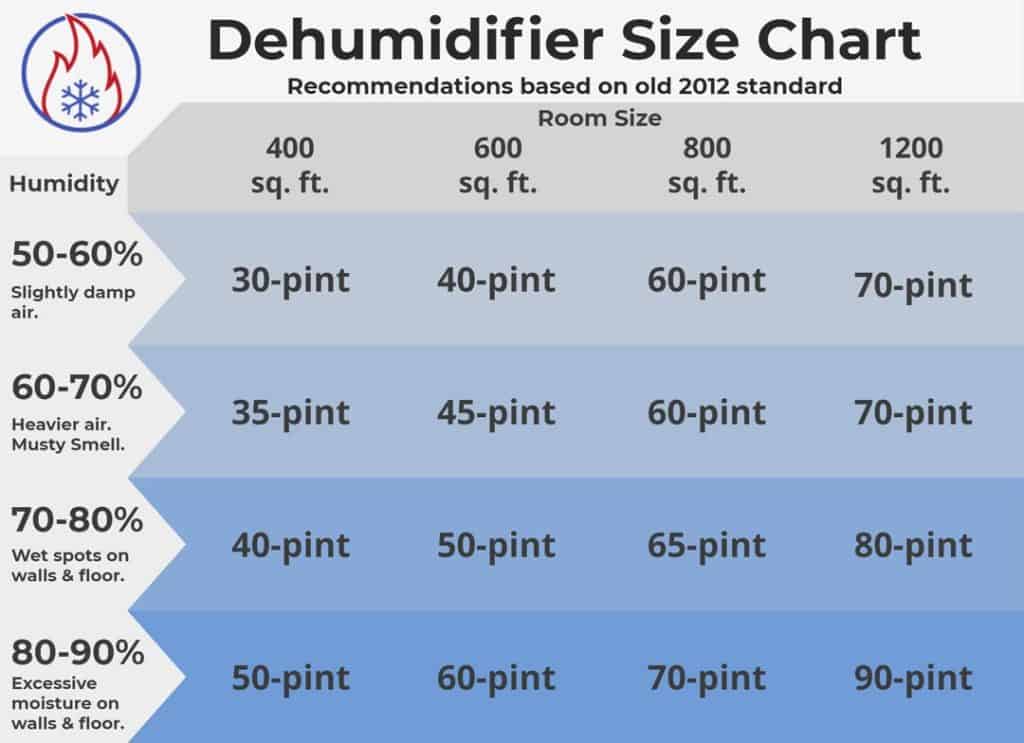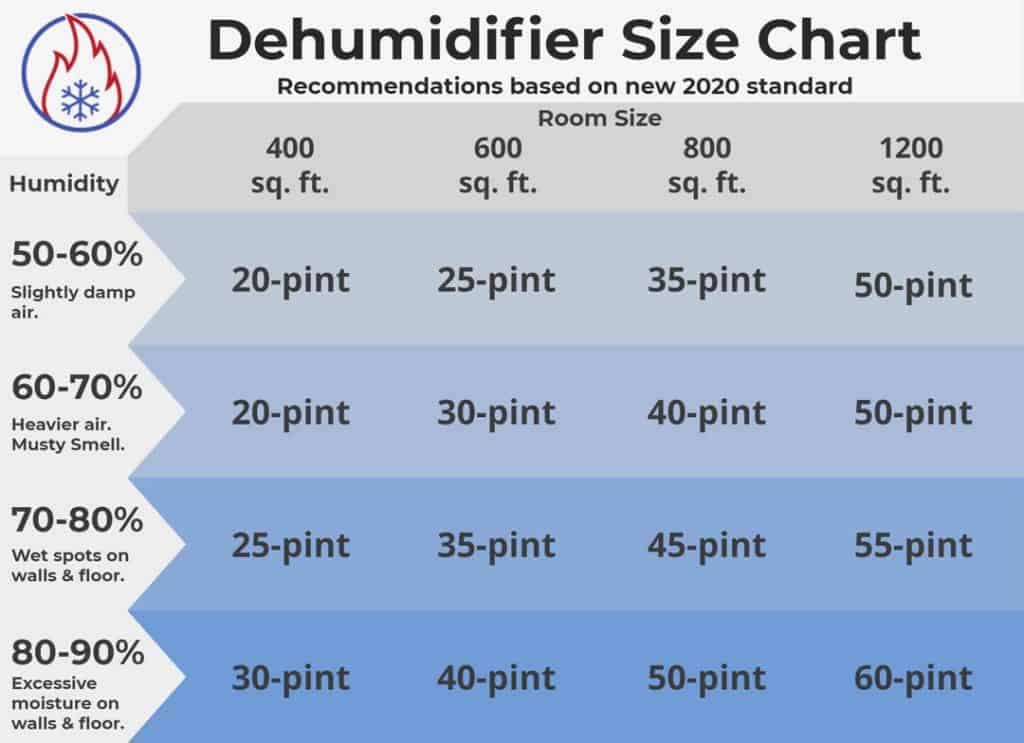HVAC Training Shop is reader-supported. As an Amazon Associate, I earn from qualifying purchases.
Protecting your home from humidity is a tough task. From muggy air to a full-blown mold outbreak, dehumidifiers have their place in preventing all sorts of issues in your home.
But how big does your dehumidifier need to be? It’s a tough question that depends on many variables.
In this article, I’ll go over the factors you need to consider before choosing a dehumidifier size.
Factors to consider when sizing a dehumidifier
There are three main factors to consider when sizing a dehumidifier:
- Humidity inside the space
- Size of the space
- Temperature inside the space
I’ll go over them below.
Humidity inside the space
The first and most obvious factor to consider is the relative humidity inside the space.
If the humidity is high in the space, then you will need a larger dehumidifier to remove that extra moisture.
I recommend using a hygrometer to get an accurate humidity reading in your space before selecting a humidifier.
It can sometimes be hard to tell what the humidity is based on feeling alone, so that’s why it’s important to take a measurement.
Size of the space
The size of the space is arguably the most important factor when selecting a dehumidifier. Simply put, the larger the space you want to dehumidify, the larger dehumidifier you will need.
For instance, if you need to dehumidify a large 1500 sq. ft. space, then you’ll need a large dehumidifier– at least 50 pints.
For large spaces, you also need to take into account the amount of airflow that your dehumidifier can provide.
Airflow is important for large spaces because you will need air circulation throughout the entire space to dehumidify it.
If you place your dehumidifier on one side of a large open room, then the opposite end of the room might stay humid.
Temperature inside the space
Finally, the temperature of the room is an important factor to consider.
Dehumidifiers work better in spaces with higher temperatures.
Dehumidifiers don’t work well in low temperatures. So if you’re going to be dehumidifying a cold room, then you’ll need a larger dehumidifier.
Most refrigerant dehumidifiers work down to temperatures around 41°F. But if you’re dehumidifying a room at those cold temperatures, don’t expect it to work very well.
The lower the space temperature, the worse your dehumidifier will perform.
Dehumidifier standards
The United States Department of Energy (DOE) sets forth the performance ratings for dehumidifiers. They also define the testing methods for rating a dehumidifier’s performance.
When it comes to rating and testing portable dehumidifiers, there are two standards used today:
- 2012 Dehumidifier Testing Standard: Requires dehumidifiers to be tested at 80°F and 60%RH.
- 2020 Dehumidifier Testing Standard: Requires dehumidifiers to be tested at 65°F and 60%RH.
Moving forward, all dehumidifiers will be tested using the new 2020 standard. However, there are still many dehumidifiers on the market that were tested to the 2012 standard.
The bottom line– make sure you know which standard a dehumidifier was tested to before you buy it.
Here’s an example of why the standards matter:
If you’re buying a 50-pint dehumidifier that’s tested to the old standard, it is capable of removing 50 pints per day when room conditions are 80°F and 60%RH.
That same exact dehumidifier will only remove about 30 pints when room conditions are 65°F and 60%RH.
So while the dehumidifier is rated at 50-pints under the old standard, it would be rated at 30-pints under the new standard.
That’s only due to the lower temperature that the dehumidifier is tested at with the new standard.
Dehumidifier sizing charts
Dehumidifier size chart – 2012 standard

Dehumidifier size chart – 2020 standard

Dehumidifier size for basement
Finding the right dehumidifier for your basement can be tricky because of varying size and humidity conditions.
Some basements are much larger than others, so it’s tough to give a general recommendation for a basement dehumidifier.
For an average-sized basement (800 sq. ft.) with high humidity (80%), I’d recommend a 45-pint dehumidifier (2020 standard).
If you need to constantly dehumidify your basement, it may be worth getting a dehumidifier with a drain spout.
With a drain spout, you can hook up a drain hose to the dehumidifier so it will constantly empty water down the drain. No more needing to empty the dehumidifier tank every day.
Dehumidifier size for bathroom
For most bathrooms, a small peltier dehumidifier will work fine. Using a dehumidifier in the bathroom is a smart move since you can drain the dehumidifier directly into the sink.
For excessive moisture issues in your bathroom, you may want to consider an exhaust fan instead.
If your bathroom only has humidity issues after using the shower, then an exhaust fan will likely work much better.
An exhaust fan will quickly remove all moist air from your bathroom, and return the humidity to where it was before you took a hot shower.
Dehumidifier size for crawl space
Most crawl space dehumidifiers are rated at 70 pints and above. A 70-pint dehumidifier is good to dehumidify a crawl space in an average-sized home (1500-2500 sq. ft.)
Crawl space dehumidifiers are unique in that they are designed to run 24/7. For that reason, they all need some level of installation.
At the very least, you’ll need to mount your crawl space dehumidifier. Either hang it from your floor joists or set it on cinder blocks.
The next step is to use flex duct to distribute air around your crawl space. This step is crucial since your dehumidifier needs proper airflow coverage to dehumidify a large space.
Also, crawl space dehumidifiers don’t have an internal tank. So you’ll need to run a condensate drain line outside so the dehumidifier can drain.
Dehumidifier size for garage
Finding a dehumidifier for your garage is a fairly straightforward process since most garages are around the same size.
For a standard, 2-car garage, you’re looking at around 400 sq. ft. of space.
Assuming a humidity level of around 70%, you’ll need a 25-pint dehumidifier (2020 standard).
The one factor that you need to take into account is the temperature of your garage.
If it’s cold in your garage, then you’ll need a larger dehumidifier. That’s why I recommend getting a larger dehumidifier for your garage.



